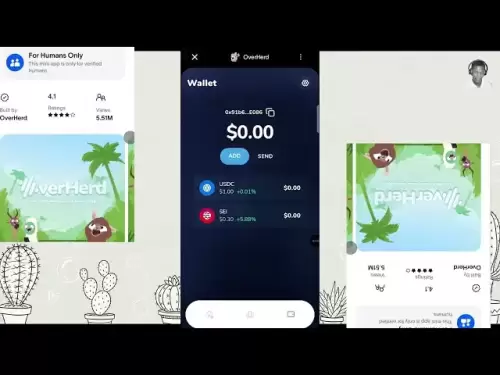-
 Bitcoin
Bitcoin $113600
-0.65% -
 Ethereum
Ethereum $3582
-2.02% -
 XRP
XRP $2.919
-4.02% -
 Tether USDt
Tether USDt $0.9999
-0.01% -
 BNB
BNB $749.8
-1.55% -
 Solana
Solana $162.1
-3.54% -
 USDC
USDC $0.9998
-0.01% -
 TRON
TRON $0.3318
-0.59% -
 Dogecoin
Dogecoin $0.1967
-4.77% -
 Cardano
Cardano $0.7148
-4.36% -
 Hyperliquid
Hyperliquid $37.30
-3.29% -
 Stellar
Stellar $0.3883
-4.29% -
 Sui
Sui $3.357
-4.00% -
 Bitcoin Cash
Bitcoin Cash $556.3
-1.84% -
 Chainlink
Chainlink $16.11
-4.08% -
 Hedera
Hedera $0.2344
-4.30% -
 Ethena USDe
Ethena USDe $1.001
0.00% -
 Avalanche
Avalanche $21.68
-4.66% -
 Litecoin
Litecoin $118.0
-3.37% -
 UNUS SED LEO
UNUS SED LEO $9.000
0.53% -
 Toncoin
Toncoin $3.161
-6.14% -
 Shiba Inu
Shiba Inu $0.00001193
-3.33% -
 Uniswap
Uniswap $9.434
-3.85% -
 Polkadot
Polkadot $3.577
-2.49% -
 Dai
Dai $0.9999
0.00% -
 Monero
Monero $288.7
-3.86% -
 Bitget Token
Bitget Token $4.209
-3.61% -
 Cronos
Cronos $0.1368
-1.06% -
 Pepe
Pepe $0.00001003
-4.60% -
 Aave
Aave $252.2
-3.73%
Difference between KuCoin leverage and contract
KuCoin's leverage trading and contract trading instruments offer distinct opportunities and risks, empowering traders to select the approach that best aligns with their risk tolerance and investment objectives.
Nov 10, 2024 at 07:48 pm

Understanding the Differences Between KuCoin Leverage and Contract Trading
KuCoin, a leading cryptocurrency exchange, offers both leverage trading and contract trading for experienced traders. While both instruments provide opportunities to potentially enhance returns, they also carry unique risks and complexities. This comprehensive guide will explore the key differences between KuCoin leverage and contract trading, empowering traders to make informed decisions based on their investment objectives and risk tolerance.
KuCoin Leverage Trading
- Concept: Leverage trading involves borrowing funds from the exchange to increase the potential profits from a trade. By employing leverage, traders can amplify their buying or selling power, enabling them to control a larger position with less capital. For example, using 5x leverage on a $1,000 trade would allow a trader to execute a $5,000 position.
- Margin Requirement: Leverage trading requires traders to maintain a minimum balance in their margin account, known as the margin requirement. This balance serves as collateral for the borrowed funds and helps mitigate potential losses. The margin requirement varies depending on the leverage level chosen and the volatility of the asset being traded.
- Profit and Loss Calculation: Profits and losses in leverage trading are calculated based on the initial margin and the leverage ratio. If the trade moves in the trader's favor, they earn a percentage of the profit multiplied by the leverage applied. However, if the trade moves against them, the losses are also amplified by the leverage ratio.
KuCoin Contract Trading
- Concept: Contract trading involves trading standardized contracts that represent the underlying asset, such as a cryptocurrency or a stock index. Contracts have a predetermined price, quantity, and expiration date, and traders can speculate on the price movements of the underlying asset without owning it directly.
- No Borrowing Required: Unlike leverage trading, contract trading does not require traders to borrow funds from the exchange. Instead, margin is used as security for potential losses. The margin requirement for contract trading is typically lower than that for leverage trading.
- Leverage Built-In: Contract trading offers inherent leverage due to the standardized nature of the contracts. The leverage is determined by the contract multiplier, which specifies the number of units of the underlying asset represented by each contract. For example, a contract with a multiplier of 100 would provide 100x leverage.
- Settlement: Contract trading involves settlement at expiration, where the trader receives the difference between the contract price and the underlying asset's price. If the contract is not held until expiration, it can be closed by placing an offsetting trade, allowing traders to realize profits or limit losses at any time.
Key Differences
- Borrowing: Leverage trading requires traders to borrow funds from the exchange, while contract trading does not.
- Margin Requirement: Contract trading typically has lower margin requirements than leverage trading.
- Leverage: Contract trading offers inherent leverage through the standardized contracts, while leverage trading allows traders to choose their desired leverage ratio.
- Settlement: Contract trading involves settlement at expiration, while leverage trading positions can be closed at any time.
- Risk: Contract trading carries less risk compared to leverage trading, as the former does not require borrowing.
- Complexity: Leverage trading is generally considered more complex than contract trading, as it involves additional aspects such as margin management and interest payments.
Disclaimer:info@kdj.com
The information provided is not trading advice. kdj.com does not assume any responsibility for any investments made based on the information provided in this article. Cryptocurrencies are highly volatile and it is highly recommended that you invest with caution after thorough research!
If you believe that the content used on this website infringes your copyright, please contact us immediately (info@kdj.com) and we will delete it promptly.
- DeriW Mainnet: Zero Gas Fees Revolutionize On-Chain Derivatives Trading
- 2025-08-06 10:30:11
- IOTA, Cloud Mining, and Eco-Friendly Crypto: A New York Investor's Take
- 2025-08-06 10:30:11
- Kaspa (KAS) Price Prediction: August 6 - Will It Break Free?
- 2025-08-06 10:50:12
- Meme Coin Mania: Arctic Pablo's Token Burn Ignites Presale Frenzy
- 2025-08-06 10:50:12
- Pi Network, Holders, and Market Turbulence: Navigating the Crypto Storm
- 2025-08-06 10:55:12
- XRP, DOGE, and the Altcoin Darling Dilemma: Where's the Alpha?
- 2025-08-06 08:30:11
Related knowledge

Why is my Bitstamp futures position being liquidated?
Jul 23,2025 at 11:08am
Understanding Futures Liquidation on BitstampFutures trading on Bitstamp involves borrowing funds to open leveraged positions, which amplifies both po...

How to report Bitstamp futures for taxes?
Jul 30,2025 at 08:35am
Understanding Bitstamp Futures and Taxable EventsWhen trading Bitstamp futures, it’s essential to recognize that these financial instruments are treat...

Does Bitstamp offer inverse contracts?
Jul 23,2025 at 01:28pm
Understanding Inverse Contracts in Cryptocurrency TradingIn the realm of cryptocurrency derivatives, inverse contracts are a specific type of futures ...

What is the difference between futures and perpetuals on Bitstamp?
Jul 27,2025 at 05:08am
Understanding Futures Contracts on BitstampFutures contracts on Bitstamp are financial derivatives that allow traders to speculate on the future price...

How to find your Bitstamp futures trade history?
Jul 23,2025 at 08:07am
Understanding Bitstamp and Futures Trading AvailabilityAs of the current state of Bitstamp’s service offerings, it is critical to clarify that Bitstam...

Can I use a trailing stop on Bitstamp futures?
Jul 23,2025 at 01:42pm
Understanding Trailing Stops in Cryptocurrency TradingA trailing stop is a dynamic type of stop-loss order that adjusts automatically as the price of ...

Why is my Bitstamp futures position being liquidated?
Jul 23,2025 at 11:08am
Understanding Futures Liquidation on BitstampFutures trading on Bitstamp involves borrowing funds to open leveraged positions, which amplifies both po...

How to report Bitstamp futures for taxes?
Jul 30,2025 at 08:35am
Understanding Bitstamp Futures and Taxable EventsWhen trading Bitstamp futures, it’s essential to recognize that these financial instruments are treat...

Does Bitstamp offer inverse contracts?
Jul 23,2025 at 01:28pm
Understanding Inverse Contracts in Cryptocurrency TradingIn the realm of cryptocurrency derivatives, inverse contracts are a specific type of futures ...

What is the difference between futures and perpetuals on Bitstamp?
Jul 27,2025 at 05:08am
Understanding Futures Contracts on BitstampFutures contracts on Bitstamp are financial derivatives that allow traders to speculate on the future price...

How to find your Bitstamp futures trade history?
Jul 23,2025 at 08:07am
Understanding Bitstamp and Futures Trading AvailabilityAs of the current state of Bitstamp’s service offerings, it is critical to clarify that Bitstam...

Can I use a trailing stop on Bitstamp futures?
Jul 23,2025 at 01:42pm
Understanding Trailing Stops in Cryptocurrency TradingA trailing stop is a dynamic type of stop-loss order that adjusts automatically as the price of ...
See all articles

























































































